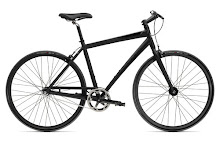Gator Country Hell Week Day 4: Bucket Brigade
"Excuse me, is this bucket taken?"
Seating was a hot ticket at lunch today as the majority of our riders somehow managed to converge on the same point at the exact same time. It was lunch, and we were situated along the side of the road in front of a small Baptist church. The sun had broken through the early morning clouds, and the section of Rt 565 south of Mascotte was picture-perfect.
Maybe it was the warmth of the pre-dawn hours. Maybe it was the fresh legs we had on the tour that joined us yesterday. And maybe it was the 10-mile stretch on the Van Fleet bike path. No matter how you slice it, thwe day was perfect, and we were burning up the roads.
Yesterday's fog never quite materialized, although for a few fleeting seconds it looked like it might descend on us. Still, as we wound our way out of Plant City and around the bustling city of Lakeland, it was heads-down hammering to Sag #1, and then off to the bike path that led to lunch.
Rock Ridge Road is a great ribbon of pavement heading east from US 98 toward Florida Highway 33. It is a little-used route that leads to the Green Swamp, where the Withlacoochee River has its headwaters. On most days users of the bike path can see giant tortoises, snakes, and even an occasional alligator crawling, slithering, or waddling along the path.
Through some miracle of harmonic convergence we all managed to come together toward the end of the path and descend upon the lunch stop two miles hence. Had it been a Sunday the faithful flock no doubt would have stood in wonderment at these Lycra-clad tourists, but we were a day early for that. Their might oak trees provided shade while Becky and Mark quickly prepared burritos.
And so it was that Jennifer G. found herself scurrying for a bucket to plop down upon to eat her lunch. Rare indeed is the day when the majority of the riders make it to lunch at the same time, so competition for the buckets is hardly ever intense. But not today.
The temptation was high to sit a spell beneath the old oak trees, but the road beckoned. Fifty miles remained before the finish near Brooksville, and the weather was so perfect that a nap could just wait until later.
Mascotte was a short eight miles up the road, and from there we headed toward Tuscanooga and Center Hill, following more lonely central Florida roads. At Center Hill, which we will visit tomorrow from the other direction, we headed south and then west to Webster, where cold watermelon and snacks awaited us at Sag #2.
We were running well ahead of our planned "windows" for the sags and lunch. The strength of the group is making planning challenging, because we keep getting faster by the day. Lunch today could more accurately have been called brunch, while Sag #2 was closer to being at the traditional lunch hour.
After Webster we zigged and zagged to the west, crossing I-75 and passing the Florida National Cemetery, and then zipping through Nobleton. Shortly after crossing the Withlacoochee River we turned left onto the bike path bearing the same name.
And then it got interesting. Rather than simply cruising into the finish at an easy pace, someone threw down the gauntlet and we were off to the races. The nine miles on the path were a blur, and we had to pay attention to not clip other cyclists, pedestrians, and families with kids sharing the path. Sweat in our eyes, we reached the parking area near Rt 50 in under 25 minutes.
With a mile to go the race was over, and we cooled the engines for the approach to the night's lodging near I-75. All told we covered 98.2 miles, which a number of us covered in about 4 hours 50 minutes riding time. It was one of the fastest Gator Week days in the nine years we've been hosting the event.
And I do believe I could have filled one of those buckets had I taken the time to wring out my clothing at the end.
Dr "Sweating Buckets" Gerlich


